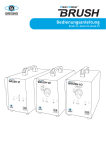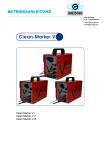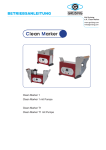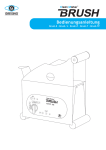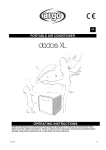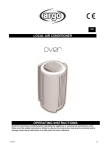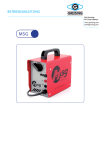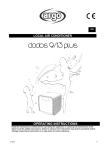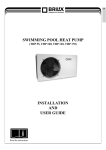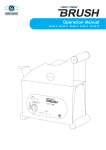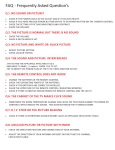Download Operating Instructions
Transcript
Operating Instructions Brush V1, Brush V2, Brush V3 3 2 1 -1- operating instructions PRODUCT DESCRIPTION Model: Unit No.: Built: CUSTOMER REGISTRATION Registration No.: The user is obliged to: · observation of EC Directive 89/655 and its national implementation · observation of the current national regulations concerning industrial safety · utilisation of the machine in accordance with the instructions All rights reserved. Printing, in whole or in part, is only allowed with prior consent of the manufacturer. Kai Greising e. K. Clean Marker www.greising.com [email protected] Industriestraße 29/2 D-73340 Amstetten Tel. +49 (0)73 31/30 58 - 0 Fax +49 (0)73 31/98 17 22 ORDER PROCESSING + 49(0)73 31/30 58 - 20 ORDERING STENCILS + 49(0)73 31/30 58 - 22 Operating Instructions Clean Marker Brush V-Series − Page 2 INDEX 1SAFETY REGULATIONS 5 1.1 Correct utilisation 1.2 Tips and definitions 1.3 Obligations and liability 5 5 5 2INTRODUCTION 7 2.1 Technical data 2.2 Conformity 2.3 Transport, storage 2.4 Accessories 7 7 8 8 3 FUNCTION, METHOD OF OPERATION 8 3.1 3.2 3.3 3.4 Function review Method of operation Safety and monitoring equipment Operating and display elements 3.4.1 Front side, front display 3.4.2 Back side 8 9 9 9 9 10 4 TRANSPORT, STARt-UP 11 4.1 11 11 11 11 Safety regulations 4.1.1 Temporary storage 4.1.2 Set-up 4.1.3 Start-up 5operation 11 5.1 Start-up 5.1.1 Instrument setting 5.2 Cleaning with the Clean Marker Cleaner (60° tool) 5.2.1 Tips for optimal cleaning 5.2.2 Cleaning process 5.3 Marking with the Clean Marker Cleaner (flat tool) 5.3.1 Tips for optimal marking 5.3.2 Marking process 5.4 The use of short-term stencils 5.5 Switching off the device 11 12 12 12 12 12 12 13 14 14 Operating Instructions Clean Marker Brush V-Series − Page 3 operating instructions 6MAINTENANCE 14 6.1 Safety regulations 6.2 Maintenance and inspection check list 14 15 7MALFUNCTIONS 15 7.1 Safety regulations 15 8 DECOMMISSIONING, Storage 15 8.1 Preparation for storage 8.2 Package, transport 8.3 Maintenance during storage 15 15 16 9DISPOSAL 16 9.1 Procedure 16 10YOUR OPINION 18 Operating Instructions Clean Marker Brush V-Series − Page 4 1 SAFETY REGULATIONS 1.1 CORRECT UTILISATION The units are intended only for the marking of metallic objects. The function is only guaranteed when original parts are used. Any other or any use beyond those determined is not considered correct. The manufacture cannot be held responsible for any damages resulting from such incorrect use. The following are also considered to be part of correct utilisation: • Compliance with operating instructions. • Compliance with inspection and maintenance requirements. • Use of protective clothing, especially gloves and goggles. 1.21.2TIPS AND DEFINITIONS Warning A possibly dangerous situation which could lead to serious injury or even death. Warning A possibly dangerous situation, which could lead to light physical injury. This sign is also used as a warning for heavy material damage. Information Concerning usage and other useful information. Information The arrow describes a following process occurring automatically and / or the condition which should now be set. 1.3 Obligations and liability 1.3.1 Necessary qualifications of operators Operation, maintenance and inspection may only be carried out by authorised and qualified specialists. The minimum age of the operator is 18. Authorised specialists are understood to be specialists trained by the user, the manufacturer or the service partner. These operators must be: • trained in the use of the unit • conversant with the operating instructions • conversant with the safety equipment of the unit • conversant with the relevant regulations (especially with accident prevention regulations) • authorised to use the necessary chemicals Operating Instructions Clean Marker Brush V-Series − Page 5 operating instructions 1.3.2 Risks involved when using the unit The unit has been built in accordance with the latest technical standards and the recognized regulations concerning safety. In spite of this, danger of injury to the user or a third party and/or damage to the unit or other materials could arise during use. The unit may only be used: • for the process previously determined • in a perfectly safe condition 1.3.3 Guarantee and liability Our „General Conditions of Sale and Supply“ are applicable. Claims of warranty and liability made for personal injuries and material damages are excluded if they result from one or more of the following causes: • incorrect use of the unit • non - observance of operating instructions • unauthorised structural changes on the unit 1.3.4 Safety measures The instructions for use are to be kept near the unit and are to be passed on by sale or exchange of the machine. All safety and danger signs on the unit are to be clearly visible at all times. 1.3.5 Risks arising from electrical energy • Work on the power supply is only to be carried out by the same electrician. • The electrical equipment is to be checked regularly. • Loose connections and damaged cables must be remedied immediately 1.3.6 Special risks arising from chemicals Dealing with chemicals should be considered a special risk. Pay attention to the Safety Data Sheets and the following remarks in these instructions: Eye protection Eyes should be protected from chemicals with goggles Hand protection Put on rubber gloves before working with chemicals Clothes protection Wear protective clothing before using chemicals (acid - proof apron, working coat) Breathing protection Fumes arise when using chemicals. Always wear a face mask! Accident with chemicals Should chemicals come into contact with eyes in spite of wearing goggles, then: • rinse the eyes with plenty of clear water • seek medical attention. Operating Instructions Clean Marker Brush V-Series − Page 6 • further information - Do not eat or drink at the workplace. - Always wash your hands before taking a break. - Keep the equipment and chemicals away from children and unskilled personal. 1.3.7 Maintenance and servicing, repairing faults The prescribed maintenance work and inspections are to be carried out on schedule. Before beginning maintenance work, inspection or repairs, switch the unit off and secure by „pulling the plug“. 1.3.8 Constructional changes on unit Without the prior consent of the manufacturer, no alterations, additions or removals of any sort may be made on the unit. Only spare or replacement parts originating from the manufacturer or his authorised dealer may be used. 1.3.9 Emission Electrolyte may vaporise during etching and cleaning. These vapours should not be inhaled. Provide fresh air circulation in your place of work. 2 INTRODUCTION 2.1 TECHNICAL DATA general data Brush-V1 Brush-V2 Brush-V3 dimensions W x H x D [mm] 145 x 250 x 330 145 x 250 x 330 145 x 250 x 330 weight, approx. [kg] 8,0 8,0 8,3 service output 380 VA 380 VA, 380 VA 2.2 CONFORMITY The unit fulfils the following regulations and standards: • EMV Directive 2004/108/EG • Low Voltage Directive 2006/95/EG The CE - label is on the front of the unit. The type plate with the special unit number is attached to the rear. Operating Instructions Clean Marker Brush V-Series − Page 7 operating instructions 2.3 Transport, Setting up Please pay attention to the transport instructions on the packaging. Keep upright. If possible, store vibration - free. 2.3.1 Environmental conditions • Temperature - 5 °C to + 55 °C • Humidity dry, indoors, dew-protected • Installation location dust-free, level, away from explosive gases • Workable materials all conductive metal surfaces 2.4ACCESSORIES The contents of the various accessory sets can be read in the current price-lists. 3 Function, Method of Operation 3.1FUNCTION With this unit, you can remove discolourations and oxide layers from stainless steel surfaces. Furthermore, you can do markings and etchings. 3.2 METHOD OF OPERATION Brush-V1 pickling with electrode pickling with brush polishing with electrode dark markings with tool Operating Instructions Clean Marker Brush V-Series − Page 8 Brush-V2 Brush-V3 Electrochemical pickling, marking and etching. 3.3 SAFETY AND MONITORING EQUIPMENT • 35 Amp (4) overload safety switch on the front of the unit • 4 Amp (7) cut-out on the rear of the unit 3.4 OPERATING AND DISPLAY ELEMENTS 3.4.1 Front side, front display (1) Red connecting socket for the working piece (earth cable) (2)Black connecting socket for the tool and brush attachments (3) Selector switch (4) Cutout 35 Amp (5) Green indicator light, showing state of operation 1 2 3 4 5 Operating Instructions Clean Marker Brush V-Series − Page 9 operating instructions When electro - polishing, material is removed from the surface of the workpiece by specific electrolytes used in conjunction with an external DC source. The material set free by the electrolyte is non - polluting and follows under flattening conditions. In contrast to mechanical removal processes, flattening by electro - polishing begins in the micro range and includes, during longer polishing periods, larger structures which are rounded and flattened off on their top surface. During electro - polishing, two different mechanisms work simultaneously, one flattens the upper surface in the micro range and the other achieves fine deburring in the macro range. 3.5.2 Reverse (6) Main switch (7) Cut-out 4 Amp 6 Operating Instructions Clean Marker Brush V-Series − Page 10 7 4 Transport, START-UP 4.1 SAFETY REGULATIONS 4.1.1 Temporary storage Always keep the unit in its outer packaging and in a dry room indoors. 4.1.2 Set-up Without using sharp tools, remove the outer packaging carefully. Keep the original packaging. Always use it for storing and transporting the unit. 4.1.3 Start-up • check that the mains voltage is the same as that on the type label and is the same as the setting • using the mains cable connect the unit to the mains voltage; push the red cable into the red connecting socket (1) • fix the earth clamp to the red cable and then on the workpiece • push the black cable into the black connecting socket (2) • fix the other end of the cable into the tool for marking and polishing or the brush for cleaning • switch on the unit at the main switch (6), the green light (5) should be lit, the unit is ready • set the unit as desired (only on V2 and V3) 5 OPERATION 5.1 START-UP Carry out a check and inspection, not only prior to initial operation, but also prior to every set up. Set up the unit as described above. Working with chemicals can be dangerous. Always wear a face mask, acid-proof apron, goggles and gloves. When using Greinox 1000 / 2000 / Polish, Rapid please read the Safety Data Sheets first (currently to be found under www.greising.com / Clean Marker /Service). Do not inhale the vapours arising. Should there be skin contact, wash with plenty of water. Operating Instructions Clean Marker Brush V-Series − Page 11 operating instructions 5.1.1 Unit adjustments for cleaning for Clean Marker Brush devices selector switch (see page 9). Clean Marker Brush V1 units do not have a selector switch and are only applicable for pickling with brush and dark markings with electrode. brush attachm. 1 (A) selector switch brush attachm. 2 (B) etching tool (C) + etching felt 1 cleaning tool 60° (D) + polishing felt symbol 1 pickling with brush 2 pickling with electrode 3 polishing 4 dark marking 5.2Cleaning with Clean Marker brush attachments 5.2.1 Tips for optimal cleaning With the Clean Marker brush attachment you can clean even inaccessible parts. The short brush shows more powerfull performance, the long brush is especially for big areas. Change the brush in time to avoid short circuits. A b 5.2.2 The „Cleaning“ Process • screw on the brush attachment • adjust the unit according to Chapter 5.1.1 • fill about 1 cm Greinox 1000, 2000, Polish or Rapid into the wide-neck container; more can be filled into the containers for pump units • moisten the tool • run the tool over the oxide layer until the surface is clean To avoid white edges on the work piece: polish the cleaned work piece with the cleaning cloth supplied, lightly moistened with water and Neutralyt. Croping the brush will increase performance. However, this may lead to short circuit signs. 5.3MARKING with the Clean Marker (flat tool) c d 5.3.1 Tips for maximum marking effect Every electrolyte contains salts. Depending on the material, these salts can have a strongly oxidizing effect. Extreme cleanliness must be used when handling the chemicals. Avoid carry - over of electrolytes and wash your hands frequently. Make sure of good power contact and moist felt. Felt which is too dry restricts the flow of power. Stencils become clogged with salts and metals after a while. They should also be rinsed and cleaned frequently. Electrolyte can also be used for cleaning stencils. Small surfaces can best be marked by simply pressing the felt on the stencil. Larger areas are best marked by stroking the tool head several times over the entire surface of the stencil. This takes between 1.5 and 2 seconds. If the marking appears rusty, then either do not use the tool quite so long or decrease the voltage. The tool should be held at right angles to the work piece and the whole surface used for contact with the stencil. Operating Instructions Clean Marker Brush V-Series − Page 12 Move slightly back and forth. the electrolyte flows better through the stencil Do not allow the stencil to become too warm as this could lead to premature wear and tear. When electrolyte vaporises it leaves residues in the stencil tissue. In time this reduces the clarity of the marking. Dark, i. e. dirty, felts must be changed frequently and the larger the stencil, the quicker the felt needs changing. The results of lettering depend on various factors. The results can vary depending on material or within a material batch. Test the lettering for quality on a piece of waste material before beginning to work. The lettering can usually be optimised by using various parameters and electrolytes. By using switch (4) you can set whether the lettering should be dark or light. The result differs with different materials. More material is removed with light lettering. The stencil gets dirty very quickly and must be cleaned more often. Light letterings are often used with stainless steel. However, the result is not predictable because each aluminium has a different oxide layer. 5.3.2 The „Etching (marking)“ Process • clean the spot to be etched • cut off 30 mm etching felt (t = 2 mm) from the 60 x 2 x 1000 strip or from the sheet • using the „O“- ring, fix the felt pad to the tool head • using the selector switch (4) set the unit to the desired setting for light or dark etching • add enough electrolyte to the felt on the underside of the tool so that it is wet • position the stencil in the desired position on the work piece • using light pressure and small swivelling movements stroke over the stencil or, if the stencil is small enough to be covered by the tool head, then simply press down and move slightly to and fro, holding the tool at right handles to the work piece • 1.5 to 2 seconds should be long enough to produce a good etching although this depends on the material and the size of the stencil • remove electrolyte from the metal surface and the lettering • neutralize the surface with a cloth soaked in Neutralyt GN 2 several times • then finally conserve the surface and the etching with Konservat GK 2 There is a special tool head for etchings wider than 30 mm. Operating Instructions Clean Marker Brush V-Series − Page 13 operating instructions 5.4 The use of short-term stencils Marking with short - term stencils • place the short-term stencil with the blue/green side facing you into the typewriter/matrix printer (without ribbon) • type the desired lettering onto the blue/green side • remove the short-term stencil and cut it to the desired size • remove the white protective paper • moisten the upper side of the short-term stencil with electrolyte • put the stencil into position on the workpiece • press the tool head onto the stencil so that the whole surface covers the stencil and move it around gently • after about 1.5 to 2 seconds (depends on the material) the process should be finished • clean the surface so that no electrolyte remains on the workpiece • neutralize the surface several times using a cloth soaked in Neutralyt GN 2 • conserve the lettering and the metal surface with Konservat GK 2 5.5 CLOSING DOWN THE UNIT • switch off at the main switch (6) and remove the mains plug • dismantle all the accessories • clean all parts 6 MAINTENANCE 6.1 SAFETY REGULATIONS Maintenance may only be carried out by an authorised person. Before beginning maintenance, switch off the unit and secure against inadvertent switching on, e. g. by „pulling the plug“. Work must be executed along the lines prescribed in Chapter 1 „safety measures“ . 6.1.1 Maintenance and inspection check list intervals control position / advice of maintenance daily, before using Check the device and the stencil/brush. If necessary replace worn parts. after using Clean stencils, tool head, cable and stainless steel working surface. Clean stencils: carefully between 2 fingers in clear water. Clean tool head: unscrew handle from carbon head and clean both in plenty of water. Clean unit and cable: wipe with a moist cloth. Operating Instructions Clean Marker Brush V-Series − Page 14 utilities a soft cloth, brush 6.2 GENERAL REMARKS Do not use cleaning agents, metal objects or compressed air. Dust and glue residues must be removed with a scraper made of plastic. Dismantle and clean the tool after use. If not, acid could concentrate to such a degree that it becomes a health hazard. The supply of power through the cable could also be affected and the performance reduced. 7MALFUNCTIONS 7.1 SAFETY REGULATIONS Repairs may only be carried out by an authorised person. Before beginning repair, switch off the unit and secure against inadvertent switching on, e. g. by „pulling the plug“. Work must be executed along the lines prescribed in Chapter 1 „safety measures“ . malfunction cause corrective short-circuit • Fibre glass is worn and must be replaced. Replace fibre glass and press overload safety switch again after a short waiting period. • The 4,0 Ampere main fuse possibly melted. performance too low or no performance • cleaning tool not cleaned • contact problem • oxidated plug If current is too high, the 4,0 Ampere main fuse might have melted. Change cable, replace clamp, dismantle and clean plug 8 DECOMMISSIONING, Storage The unit must be stored in the environment described in Chapter 4.1. 8.1 PREPARATION FOR Storage Clean the unit and accessories and make sure that all the equipment is carefully packed and the chemical containers are closed firmly. 8.2 PACKING, TRANSPORT Always store the original packaging. Use it for storing and for transport. Operating Instructions Clean Marker Brush V-Series − Page 15 operating instructions 8.3 MAINTENANCE DURING STORAGE There is no maintenance to be carried out during storage. Electrolyte, Neutralyt and Konservat should be kept in a cool and dark place, protected from direct sunlight. 9DISPOSAL Disposal of old Electrical & Electronic Equipment (applicable throughout the European Union and other European Countries with separate collection programmes). This symbol, found on your product or on its packaging, indicates that this product should not be treated as household waste when you wish to dispose of it. Instead, it should be handed over to an applicable collection point for the recycling of electrical and electronic equipment. By ensuring this product is disposed of correctly, you will help prevent potential negative consequences to the environment and human health, which could otherwise be caused by inappropriate disposal of this product. The recycling of materials will help to conserve natural resources. For more detailed information about the recycling of this product, please contact your local city office, household waste disposal service or the retail store where you purchased this product. 9.1 PROCEDURE • Use Neutralyt GN 2 to neutralize Greinox waste to pH 7. • Used fibreglass pads, cloths and fluid remains should be neutralised to pH 7 with Neutralyt GN 2. • The soiled water can then be disposed off in the normal way. • Fibreglass and cloths contain metal components and should be disposed of as if metal waste. Operating Instructions Clean Marker Brush V-Series − Page 16 Electronic waste. Dismantle into component parts (transformers, mother boards, cables, etc.) and dispose of in accordance with local regulations. Materials: Metals, non - metals, composites and accessories should be sorted and disposed of correctly. welded seam cleaned uncleaned Operating Instructions Clean Marker Brush V-Series − Page 17 operating instructions cable in outlet yes no put cable into outlet switch on unit no light is lit light is not lit ja connect cable and tool red and black cable, tool connected no clean tool check cut out 4 A, replace if necessary yes Unit is overheated. Wait approx. 6 min. and try again. Overload safety switch 16 A activated. unit works no yes no yes push overcurrent cutout OK Operating Instructions Clean Marker Brush V-Series − Page 18 Service 10 WE ARE INTERESTED IN YOUR OPINION We constantly strive for an improvement in quality and would be interested to have your opinion concerning our products and operating instructions. Please use this fax form. Customer: Unit type: Order no. : Please call us back on number: Remarks, suggestions: Date:Name: Operating Instructions Clean Marker Brush V-Series − Page 19 12 DECLARATION OF CONFORMITY According to Low Voltage Directive 2006/95/EG Manufacturer: Kai Greising e. K. Clean Marker Industriestr. 29/2 D-73340 Amstetten Tel. 07331 / 30 58-0 Fax 07331 / 98 17 22 Description of components: Electrochemical pickling and etching units The CE - sign was attached for the first time 2013 Type: Clean Marker V Brush We hereby certify, as manufacturer, the conformity of the mentioned components with the European standards, especially with the product standards of the DIN EN 61558 (VDE 0570) standards and the conformity with the Low Voltage Regulations 2006/95/EG. The safety directions included in the product documentation are to be observed. Siegfried Maier Production ManagerAmstetten 02.03.2013




















